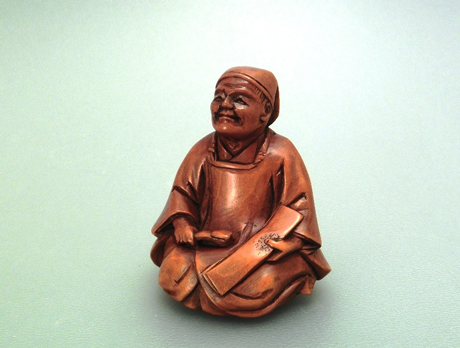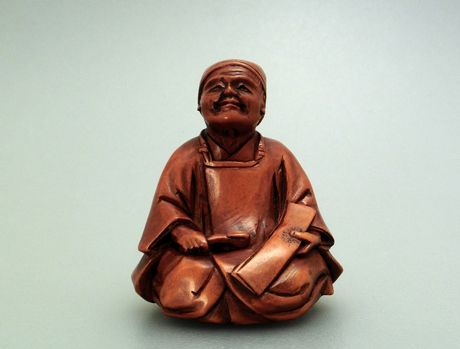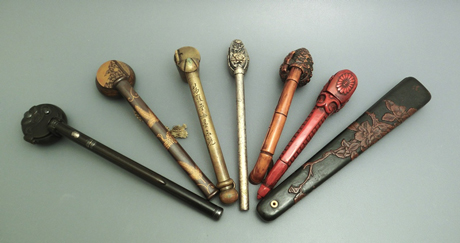TOP > Newsletter > back Number Vol.4
SAGEMONOYA Newsletter back Number Vol.4
Matsuo Basho and his Yatate
Amongst all regions in Japan, surprisingly Tokyo was the first to welcome the start of cherry blossoms blooming following this year’s Spring Equinox.
さまざまの こと思い出す 桜かな 芭蕉
Samazama no koto omoidasu sakura kana
how many, many things
they call to mind
these cherry blossoms
~Matsuo Basho (tr. R. H. Blyth)
Matsuo Basho (1644 – 1694) also known as Haisei (俳聖 meaning “Master of Haiku”, name principally used for Basho) was forty-five when he wrote the above poem in 1688 whilst viewing Sakura (cherry blossoms) in Iga, remembering the time when he viewed it with his ill-fated lord Todo Yoshinaga who passed in his mid-twenties.

Matsuo Basho. Netsuke. Wood. late 19th C. 46mm
A Netsuke of Matsuo Basho is a rare kind. Here he is holding a strip of paper in the left hand and Yatate in his right. Yatate, a portable writing instrument which holds brush and ink, was essential for people in the Edo period before pens and pencils were introduced to the commoners.

After he wrote this Haiku, Basho embarked on his long and dangerous journey to write what will be known as one of the masterpieces of classical Japanese literature, Oku no Hosomichi (“The Narrow Road to the Interior”), the same year in which the 500th anniversary of the death of Saigyo Hoshi, another renowned poet whom Basho admired, was commemorated.
In the early morning of the 27th day of the third lunar month, Basho departed from the tea house owned by his patron/follower, Sugiyama Sanpu, bound for Senju, his first destination. When he arrived, Basho wrote in honour of Sanpu, an official fishmonger appointed by the government whom he bid farewell:
「行く春や 鳥啼(なき) 魚の目は泪」
Yuku haru ya tori naki uo no me wa namida
departing spring
birds cry, in the fishes’
eyes are tears
~Matsuo Basho (tr. Barnhill)
Basho continued, expressing his sense of lingering farewell with the mention of Yatate:

Various Yatate. Edo-Meiji Period
是を矢立の初めとして、行く道なほ進まず
Kore o Yatate no hajime toshite, ikumichi naho susumazu
This is the first time I use Yatate,
yet still reluctant to venture farther
After over three hundred years, these verses still resonate with our Japanese soul.
How about leaving our mobile phones and pick up Yatate instead, write an ode or two under blooming trees. Perhaps we may be able to impress those who may read them in the 24th Century?
SAGEMONOYA Newsletter back Number
- • Newsletter vol.11 Japanese mask culture and clay mask Netsuke
- • Newsletter vol.10 Netsuke and Sake
- • Newsletter vol.09 Dragons and Amaryu
- • Newsletter vol.08 Dogs and Puppies
- • Newsletter vol.07 Walnut Netsuke
- • Newsletter vol.06 Children’s Sumo
- • Newsletter vol.05 Shoki ~ The Demon Queller ~
- • Newsletter vol.04 Matsuo Basho and his Yatate
- • Newsletter vol.03 Setsubun & Masumasu Hanjo
- • Newsletter vol.02 Fukusuke san
- • Newsletter vol.01 Tanuki no Haratsuzumi
- • SAGEMONOYA Newsletter TOP



